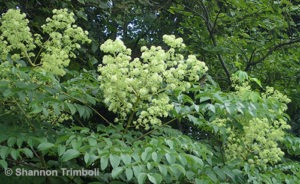
Devil’s walking stick (Aralia spinosa) is a small tree or tall shrub that is native to the eastern U.S. It is often found growing along the edges of forests or in open woodlands. Devil’s walking stick can be a very important plant for honey bees, native bees, and butterflies.
From approximately mid-July to mid-August, devil’s walking stick produces huge clusters of white flowers. I always forget how common devil’s walking stick can be in places until I drive down the roads when it is in bloom. The white flowers produce abundant pollen and nectar that insect pollinators love. The flowers are especially attractive to honey bees and native bees.
For beekeepers, the timing of the flowers is a huge plus. Mid-July to mid-August in Kentucky is during what is commonly called the summer dearth by beekeepers. The summer dearth is simply a time when there are fewer plants blooming that honey bees use. Or, at least the quantity of flowers available isn’t as high as during the spring or early fall. It is a time when honey bees have a harder time finding large supplies of nectar and pollen to gather and store. So, plants that bloom during this time and that honey bees will use are often of interest to beekeepers.

After the flowers are pollinated, they produce dark berries. The berries tend to ripen in September and early October. Birds LOVE the berries. They will quickly pick clean the ripened berries. Last fall I was going to gather some of the berries to plant from the devil’s walking stick on our farm, but the birds beat me to them. I’m hoping for different results this year. We’ll see what happens.
Devil’s walking stick gets its name from the small, but sharp, thorns that are found around the trunk. The thorns tend to form rings around the trunk. It is not the sapling that you want to grab ahold of in the woods. Another name for it is Hercules’ club, also because of the thorns.
Devil’s walking stick can be used as a native ornamental when it is planted in areas where the thorns won’t pose a problem. The growth form is kind of umbrella shaped. The leaves are bi-pinnately compound and can reach over 3 feet in length. The long, bi-pinnately compound leaves plus the large clusters of flowers and then berries can make the plant look like something that would be found in a tropical rain forest. Devil’s walking stick would be a unique and valuable addition to a native or pollinator-friendly landscape.


This article was part of Shannon’s original Kentucky Pollinators and Backyard Wildlife blog which evolved into the blog for Backyard Ecology.

Backyard Ecology: Exploring Nature in Your Backyard
Nature isn’t just “out there.” It’s all around us, including right outside our doors. Hi, my name is Shannon Trimboli, and I am the host of Backyard Ecology. I live in southcentral Kentucky and am a wildlife biologist, educator, author, beekeeper, and owner of a nursery specializing in plants for pollinators and wildlife conservation. I invite you to join me as we ignite our curiosity and natural wonder, explore our yards and communities, and improve our local pollinator and wildlife habitat. Learn more or subscribe to my email list at www.backyardecology.net.

Leave a Reply